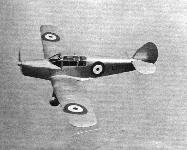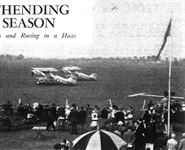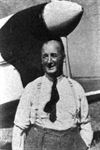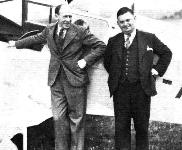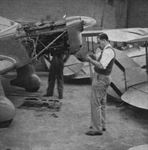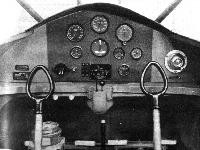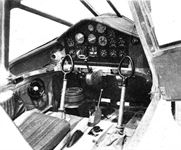
Варианты
- Percival - Gull - 1932 - Великобритания
- Percival - Vega Gull / K.1 - 1935 - Великобритания
- Percival - Proctor / P.28 - 1939 - Великобритания
Percival. Самолеты семейства Gull
<...>
Четырехместный Type K.1 Vega Gull совершил полет в ноябре 1935 года, он имел двойное управление, закрылки и такой же двигатель, как у Gull Six, а на более поздних моделях ставились двигатели Gipsy Six Series II мощностью 205 л.с.
Vega Gull достигли нескольких успехов в гонках и полетах на дальние дистанции, всего было построено 90 машин (последняя - в июле 1939 года).
Машины продавались в Австралию, Канаду, Индию, Ирак, Японию и Кению. Они использовались для связи, а позже были усовершенствованы в вариант Proctor.
<...>
Описание:
- Percival. Самолеты семейства Gull
- Flight, January 1936
A ROOMIER PERCIVAL - Flight, April 1936
MODERN LIGHT AIRCRAFT REVIEW - Flight, October 1936
VEGA VICTORIOUS - Flight, March 1938
British light aircraft - Flight, October 1938
British Sport and Training types - Flight, November 1939
Britain's Civil Aircraft
Фотографии
-
Air Pictorial 1991-10
Регистрационный номер: G-AEZJ, D-IXWD, PH-ATH, SE-ALA Pictured at its new base at White Waltham, Vega Gull G-AEZJ is now flying following rebuild with Cliff Lovell near Salisbury, Wiltshire. The Vega was first registered G-AEZJ in the UK in July 1937 before being exported to Holland. The aircraft arrived in the UK from Sweden in 1987 for restoration, after spending its time in Europe registered PH-ATH, D-IXWD and later SE-ALA.
-
Jane's All the World Aircraft 1938 / 03 - All the world's aeroplanes
Регистрационный номер: G-AEYC [4] The Percival "Vega Gull" Four-seat Cabin Monoplane (200 h.p. D.H. "Gipsy-Six" engine).
-
Aeroplane Monthly 1983-01 / J.Silvester - Percival Aircraft 1933-1954 (1)
Регистрационный номер: G-AEYC [4] Vega Gull G-AEYC survived until August 1960 when it was burnt at Gatwick.
-
Flight 1937-10 / Flight
Регистрационный номер: L7272 [2], G-AFWG [2] A Percival Vega Gull (Series I Gipsy Six) which is at present being shipped out to Buenos Aires for the use of the British Air Attache there, Group Capt. A. J. Miley, and his assistant, Sqn. Ldr. P. C. Wood. A Vega Gull is already in use by the Attache in Berlin, Group Capt. F. P. Don.
-
Flight 1939-08 / Flight
“SPORTS TOURERS” FOR THE SERVICE: For communication and liaison work, the Royal Air Force is taking delivery of a number of Percival Vega Gulls (D.H. Gipsy Six II). The machines are generally similar to their civil prototype though it will be noted that the windscreen is now more streamlined.
-
Flight 1937-11 / Flight Advertisements
Регистрационный номер: G-AEAD [3] Flying exactly the same standard Percival "Gull" in which she first created history by flying the South Atlantic, Miss Jean Batten has now lowered the Australia-England record by 14 hours, to 5 days, 19 hours.
-
Aeroplane Monthly 1983-01 / J.Silvester - Percival Aircraft 1933-1954 (1)
Регистрационный номер: L7272 [2], G-AFWG [2] Vega Gull L7272 was supplied to the Air Attache in Buenos Aires and became G-AFWG in June 1939
-
Flight 1936-04 / Flight Advertisements
Регистрационный номер: G-AEAD [3] ECONOMICAL TRANSPORT: A pleasant impression of one of the new Percival Vega Gulls above the clouds. With a Gipsy Six engine, this machine carries three passengers, in addition to the pilot, at a cruising speed of 150 m.p.h., and should prove popular for feeder line and charter work as well as for private ownership. A detailed description of the machine appeared in Flight of January 2.
The prototype Vega Gull, G-AEAB, during an early flight. -
Aeroplane Monthly 1983-01 / J.Silvester - Percival Aircraft 1933-1954 (1)
Регистрационный номер: G-AEAB [2] First of the Series II version of the Vega Gull was G-AEAB, with moulded Perspex windscreen.
-
Flight 1937-07 / Flight
The Percival Vega Gull demonstrating its slow-flying capabilities with flaps down
-
Flight 1938-11 / Flight
MOST OF MELBOURNE: The Percival Vega Gull which is used by the Shell Company of Australia, photographed when flying over the capital of Victoria. The distinctive colour scheme is interesting, though it makes a peculiar difference to the natural lines of the machine.
-
Flight 1937-09 / Flight
The Woolsington wind-sock gives some indication of the strength of the wind at the Newcastle control. The machine coming in is the Vega Gull flown by Miss Dillon and Capt. Neville Stack.
-
Flight 1938-09 / Flight
A bird's eye view of a small section of the member’s enclosure. In the haze, above the two Hart Trainers, can be seen the Percival Vega Gull, flown by Mr. D. M. Bay.
Другие самолёты на фотографии: Hawker Hart - Великобритания - 1928
-
Air-Britain Archive 1982-03
Регистрационный номер: G-AEAB [2] Vega Gull G-AEAB is seen in the centre of this group of Gulls being prepared for racing at Gravesend on 18.8.36. The far aircraft is unidentified but in the foreground is Mew Gull G-AEKL which won the King's Cup the following year.
Другие самолёты на фотографии: Percival Mew Gull - Великобритания - 1934
-
Flight 1936-07 / Flight
The Percival "family" was represented at Hatfield by a Gull, a Vega Gull, and a Mew Gull. All three machines have Gipsy engines. The Vega Gull is in the foreground.
-
Flight 1937-09 / Flight
All the Vega Gulls except one, as shown here, will have Series II Gipsy Sixes with D.H. v.p. airscrews.
-
Flight 1937-11 / Flight
The Percival Vega Gull has been obtainable for some time with a Series II engine and v.p. airscrew, increasing the cruising speed and the permissible all-up weight while reducing the normal take-off run
-
Flight 1935-12 / Flight
SCALED UP. This is the new Percival Vega Gull which was demonstrated at Gravesend last Thursday. Its fuselage and wing are larger than those of the standard Gull and there are four seats permitting side-by-side seating for two pairs of passengers. With a 200 h.p. Gipsy Six the maximum speed is 170 m.p.h. - perhaps rather more - and this fact, linked with the large capacity of the cabin, suits the machine for high speed charter work in addition to its function as an aerial saloon for private owners.
-
Flight 1936-07 / Flight
Gardner's victorious Vega Gull taxies in after its grand race.
-
Flight 1936-01 / Flight
The cabin of the Vega Gull is 44 in. wide and permits side-by-side seating without cramping.
-
Flight 1938-04 / Flight
P.O. AT ST. MORITZ: The Hon. Drogo Montagu sends this snap, which he took recently at the St. Moritz mountain airport. He says that the machine shown, Mr. Ian Walker’s Vega Gull, was the first British privately owned aircraft to land there.
-
Flight 1937-09 / Flight
IMPRESSIONISM: An effective portrait of Air Hire's new v.p. Vega Gull at Heston. This machine has a good deal of special equipment for night operations.
-
Flight 1936-10 / Flight
Resistance to the 205 h.p. of Vega Gull No. 7, manned by F/O. D. W. Llewellyn and C. F. Hughesdon.
-
Flight 1936-10 / Flight
Mr. Giles Guthrie and Mr. C. W. A. Scott and their victorious Vega Gull (D.H. Gipsy Series II engine) entered by Mr. Guthrie's father, Sir Connop Guthrie.
-
Air-Britain Archive 1985-01
Регистрационный номер: G-AFIE This late production Vega Gull, G-AFIE, was initially sold to Smith's Aircraft Instruments Ltd and based at Hatfield. On October 10, 1940 it was destroyed during a German air raid on Hendon aerodrome.
Vega Gull G-AFIE which was used by Smith's Aircraft Industries as a wartime communications aircraft in civil marks until destroyed in 1940. -
Aeroplane Monthly 1990-10 / Personal album. Civil
Регистрационный номер: G-AFEA [2] Another Percival aircraft previously owned by Alex Henshaw was this Vega Gull, G-AFEA. It was in this aircraft that Henshaw and his father surveyed the route for the 1939 record Cape flight, made in Mew Gull G-AEXF pictured above. During the war G-AFEA was owned by the Gloster Aircraft company and based al Hucclecote. Post-war the Vega Gull lived at Fairoaks.
-
Air-Britain Archive 1986-02
Регистрационный номер: G-AFEA [2] G-AFEA Vega Gull used by Alex Henshaw in 1938 to survey his Cape record flight route, seen here at Shoreham before the South Coast Air Race on 7.8.51
-
Мировая Авиация 211
Регистрационный номер: G-AFEH [2], G-AHVN [2] Vega Gull - продолжатель линейки Gull Six. Данный самолет был приобретен британскими ВВС и дислоцировался на авиабазе Кеттерик.
-
Flight 1937-09 / Flight
"... a quick inspection of the new control tower and buildings at Liverpool ..." The A.S.T. Dragonfly and Vega Gull on the tarmac at Speke.
Другие самолёты на фотографии: De Havilland Dragonfly / D.H.90 - Великобритания - 1935
-
Air-Britain Archive 1984-03
Регистрационный номер: G-AFBW, W9377 Vega Gull G-AFBW with difficult-to-read registration became the Royal Navy's W9377 on impressment but its subsequent fate is not known.
-
Flight 1938-03 / Flight
Регистрационный номер: G-AFAV [2] A fast four-seater - the Percival Vega Gull, shown here with a Series II Gipsy Six and v.p. airscrew.
-
Flight 1939-04 / Flight
Регистрационный номер: G-AFAV [2] Hardly in the transport class, but nevertheless a useful type for charter and feeder-line work - the Percival Vega Gull.
-
Flight 1936-11 / Flight
C. W. A. Scott's Vega Gull has a Gipsy Six II and variable-pitch airscrew.
-
Air-Britain Archive 1984-03
Регистрационный номер: G-AFEH [2], G-AHVN [2] First owned by H.F. Broadbent, Vega Gull G-AFEH became G-AHVN after the war but although the error was corrected it was wfu in 11.50 and later broken up at Blackpool.
-
Flight 1936-01 / Flight
Регистрационный номер: G-AEAD [3] OUTSTANDING CIVIL TYPE: One of four machines which made their first appearance during 1935: (3) the Percival Vega Gull four-seater with Gipsy Six;
-
Air-Britain Archive 1981-01
Регистрационный номер: G-AEYC [4] Looking a little worse for wear, Vega Gull G-AEYC was seen at Baginton on 9.7.60 wearing the name "Gertie II" and carrying an Australian flag on the fin. Only a month later it suffered fire damage starting up at Gatwick and after an abortive attempt to rebuild it at Barton it was scrapped in May 1961.
-
Air Pictorial 1961-12
Регистрационный номер: SE-ALZ The Luftwaffe Vega-Gull with Swedish registration
-
Flight 1936-01 / Flight
Despite the fact that the Vega Gull has the same power plant as last year's three-seater Gull it carries its four passengers at 170 m.p.h. Capt. Percival, in fact, says that the maximum speed is a shade over this figure.
-
Flight 1937-04 / Flight
Mm. Pissavy and Cornet with their Vega Gull at Le Bourget last Sunday on their arrival from French Indo-China in record time.
-
Flight 1936-07 / Flight
Ministering to Gardner's Vega Gull during the eliminating contest. Refuelling was done with the engine running.
-
Flight 1936-10 / Flight
The Llewellyn-Hughesdon Vega Gull being refuelled at Vienna
-
Flight 1939-12 / Flight
Australia’s Minister of Supply, Mr. R. G. Casey, and his family. He flies a Percival Gull.
-
Flight 1939-06 / Flight
The winner of the Manx Air Derby, Mr. Albert Henshaw, Sen., who flew with Mr. Alex Henshaw as co-pilot. His Vega Gull averaged 167 1/2 m.p.h.
-
Flight 1936-08 / Flight
In second place: Mr. S. W. Sparkes and his passenger with their Percival Vega Gull.
-
Flight 1938-04 / Flight
Mr. Broadbent waves on his arrival at Hanworth for the benefit of the news cameramen. The actual flight had ended at Lympne last Friday
-
Flight 1937-09 / Flight
In spite of the large aggregate amount of sea-crossing, very few competitors took the precaution of wearing life-saving jackets. Derek Schreiber (right) and Flt.-Lt. Peel, his navigator, were among the exceptions.
-
Flight 1937-09 / Flight
Two wide doors simplify, as far as possible, the business of entry into the front or rear seats of the Vega Gull.
-
Flight 1936-09 / Flight
The Percival Vega Gull (D.H. Gipsy Six), which bids fair to emulate the memorable feats of the Gull. Note in this view the large spinner over the hub of the Ratier V.P. airscrew on the Vega used by Mrs. Markham (inset).
-
Flight 1936-10 / Flight
The reckoning: a study of the weighing of the Llewellyn-Hughesdon Vega Gull.
-
Flight 1937-01 / Flight
CEREMONY: At the new Percival works at Luton, and in the presence of the Mayors of Luton, Monmouth and Abergavenny, Mr. David Llewellyn's Vega Gull was last week christened County of Monmouth by the Mayor of Newport. The machine, which has a Gipsy Six Series II engine and v.p. airscrew, will be used for a Cape record attempt. It would appear that one of the distinguished visitors involuntarily shared the Vega Gull's champagne bath.
-
Flight 1938-05 / Flight
INTERLUDE: On the face of it, hardly an air transport subject, this photograph of Mr. H. F. Broadbent (with two sentries and five porters), standing in front of his sun-protected Vega Gull at Sesok, on Flores, where he landed on his outward record attempt. Nevertheless, Qantas, K.L.M. and K.N.I.L.M., not to mention the Netherlands navy and the D.H. company, made it possible for a new airscrew to be sent and fitted in record time.
-
Flight 1936-01 / Flight
Say "Ah!" Capt. E. W. Percival, designer of the Vega Gull, inspects the flaps (which are of greater area than those of the Gull) on the machine he demonstrated at Gravesend.
-
Flight 1936-01 / Flight
An improved wing-folding arrangement has been introduced on the Vega Gull. It embodies a tommy bar (which disappears inside the wing) in place of the old fixed handle.
-
Flight 1936-10 / Flight
The Vega's business end - the series II Gipsy Six with its "1,000" size De Havilland V.P. Airscrew. There is only one external oil pipe.
-
Flight 1937-09 / Flight
The instruments and engine controls of the v.p. Vega Gull. On the extreme right is the landing and navigation light switchboard, while on the left is the useful left-hand additional throttle lever. At the base of the dashboard can be seen (on the left side) the fuel pump, airscrew pitch and intake controls, with (behind the dua! stick) the flooding control. The gauges for the four fuel tanks are on the right of the dash, and the boost gauge is in the centre at the top.
-
Flight 1936-10 / Flight
An interior view of Scott and Guthrie's victorious Vega Gull. In the top row of instruments, left to right, are the A.S.I., Sperry artificial horizon (on resilient mounting) and altimeter; in the second row are the r.p.m. indicator, oil gauge, Reid and Sigrist turn and bank indicator, clock, and ammeter, Carburetter and airscrew pitch controls are in the centre. Note the airscrew pitch-changing lever on the left of the near-side control column.
-
Flight 1936-04 / Flight
The general arrangement of the surprisingly roomy cabin is apparent in this Flight sketch. The small lever on the left of the pilot's seat (although in this case only one set of controls is fitted, dual controls are optional) operates the split trailing-edge flaps.
There is, as will be seen, ample room, and the luggage is stowed in a compartment at the rear of the cabin. The seating plan indicates the very useful width of the two doors. -
Flight 1937-03 / Flight
There is a genuine saloon car effect about the interior of the Percival Vega Gull.
-
Flight 1939-09 / Flight
A normal layout of ths Vega Gull showing the ample door width and seating arrangement.
-
Flight 1936-10 / Flight
How the airscrew pitch is changed - the simple control (to the right of the throttle and altitude control) in the Vega Gull.
-
Flight 1936-07 / Flight
Регистрационный номер: G-AELE Mr. W. Lindsay Everard's Vega Gull The Leicestershire Fox IV goes to earth at Shoreham. Mr. P. Q. Reiss, its pilot, was turning on the ground when the machine was caught by a gust.
-
Air-Britain Archive 1984-02
Регистрационный номер: G-AEYC [4] Undignified pose for Vega Gull G-AEYC at Gransha Mental Hospital, Londonderry on 30.1.39.
-
Flight 1936-01 / Flight
One half of the simplified undercarriage is revealed
-
Flight 1936-01 / Flight
General arrangement of the Vega Gull.
- Фотографии



